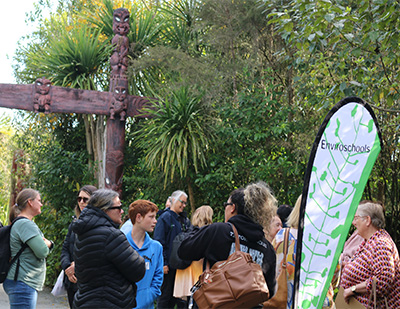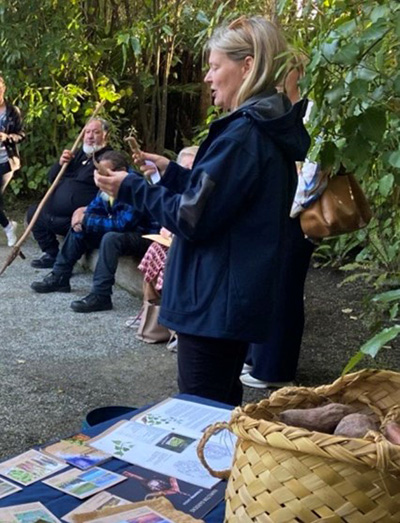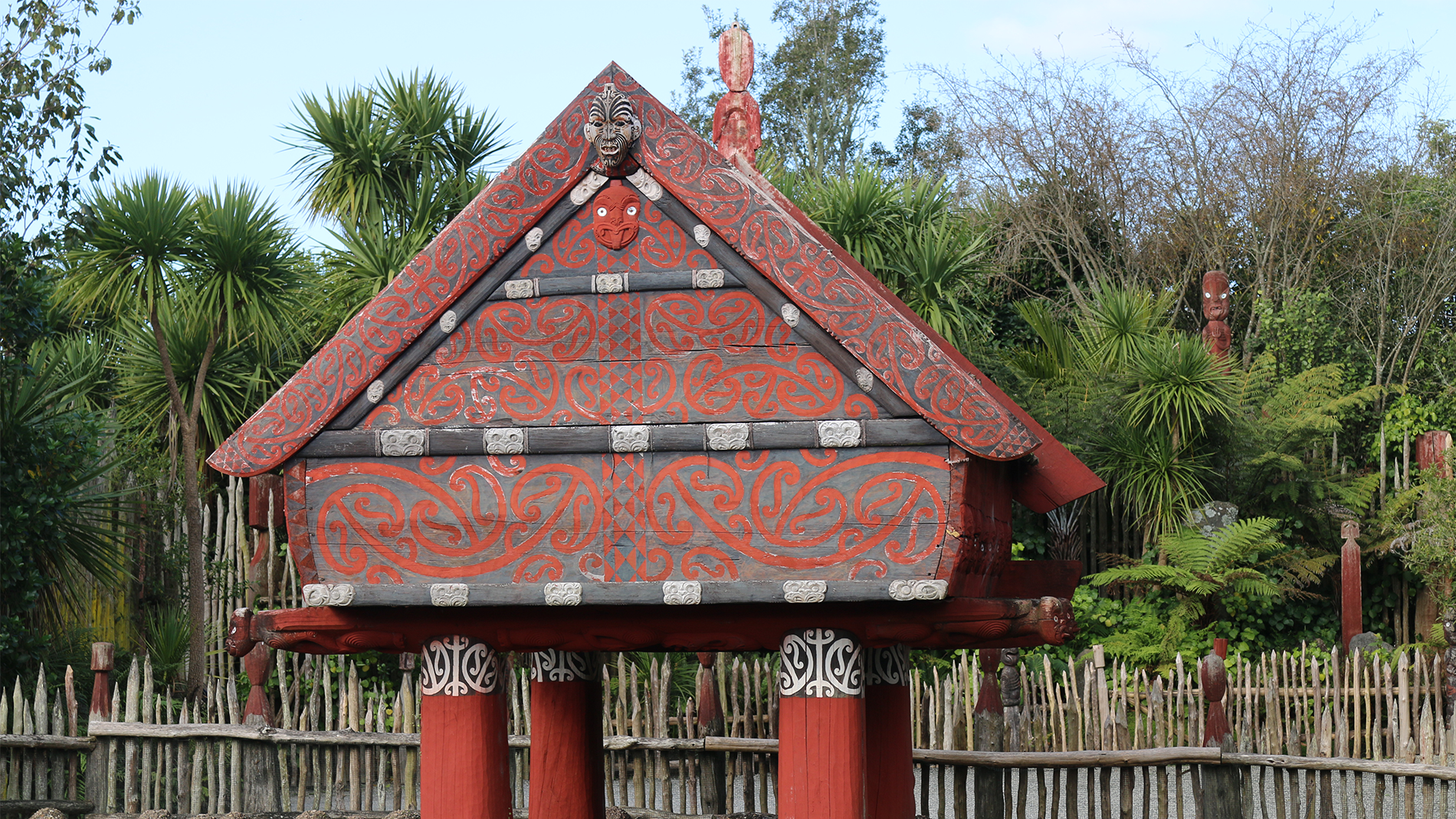"The free-draining alluvial river soils of the natural terraces along the Waikato River - the kirikiri that gave Kirikiriroa its name - provided ideal growing conditions."
- Wiremu Puke, Ngaati Wairere

Teachers from 12 schools gathered at Te Parapara Garden at Hamilton Gardens for the Enviroschools wānanga
Kūmara are as iconic to New Zealand as pavlova, creamed pāua or kapa haka. The taste of freshly roasted kūmara covered with gravy or the unique earthy smell of kūmara drawn from a hangi are true Kiwi experiences.
But before they arrived on our plates, in our vege garden (or on our supermarket shelves); before they even arrived on these shores, the humble kūmara crossed the largest ocean ever traversed in the ancient world.
In fact, the presence of kūmara, which are indigenous to South America, in Aotearoa, speaks to the legacy of one of the greatest navigational and seafaring cultures the world has ever seen.

Wiremu concludes his kōrero and Facilitator Alex Daniel explains the significance of Taputini seed kūmara
The story of the staple crop’s arrival and the care with which it was cultivated in the fertile soils of Kirikiriroa provided the captivating focus of a recent wānanga (workshop) for teachers from across the Waikato.
The session was led by Wiremu Puke of Ngaati Wairere in the picturesque setting of Te Parapara Garden at Hamilton Gardens.
It welcomed 17 teachers from 12 schools involved in the Enviroschools programme. Enviroschools, which now covers more than half of all schools in the Waikato region, encourages students to explore, learn and take action towards creating a sustainable community.
The wānanga gave teachers the opportunity to grow their appreciation of how kūmara are valued, expand their understanding of the local cultural history behind their cultivation in Kirikiriroa and develop their knowledge to get great results in their school māra kai (food gardens).
Wiremu Puke said: “Hawaiki was where Māori tūpuna came from – their place of origin and source of life.
“On their voyage to Aotearoa, they carried with them kūmara tupu. When they landed, through exploration and adaptation, they found the best places and practices to nurture its mauri.
“Whakaotirangi, who brought a kete of kūmara aboard the Tainui waka, is remembered for planting abundant gardens at Hawaiki iti, Aotea harbour, which was named after Hawaiki.”
“In Kirikiriroa, a māra kai (food garden) which carried that name and esteem was also planted at Wellington Street Beach, a reminder to the mana whenua of where they came from and of the life-giving sustenance the kūmara provided.
“The free-draining alluvial river soils of the natural terraces along the Waikato River – the kirikiri that gave Kirikiriroa its name – provided ideal growing conditions.
“This whenua was one of the most extensively cultivated areas in pre-European times. Kūmara mounds found in Chartwell have been carbon dated to between 1550 and 1625. And reports from the 1800s tell of river terrace gardens stretching 14 miles upriver from Ngāruawāhia into what is now Hamilton city.”
During introductory whanaungatanga, teachers had the opportunity to build connections with each other and their hosts. Wherever they hailed from in Hamilton, Wiremu was able to name the kūmara garden that once grew there.
Enviroschools facilitator Alex Daniel, who helped organise the session, said: “We’re so lucky to have experts like Wiremu to lead this kaupapa. Today’s workshop was a great opportunity for teachers from Waikato schools to learn from the rich history, knowledge and custom that’s been passed down by mana whenua for generations.”
A highlight of the deeply informative wānanga was Wiremu’s explanation of the tikanga for kūmara planting and harvesting. Fires were always kept burning when planting. The smoke kept away pests, such as moths, and the fire was also used to kill weeds.
One tupu was placed under each mound, each mound symbolic of a woman’s womb, always facing east towards the sun. The distinctive palisade fences of wooden spikes, faithfully reconstructed at Te Parapara Garden, were used to keep pūkeko and introduced pigs from digging up the crops.
Planting times were set by the maramataka (lunar calendar), with the rising and setting of stars that marked the changing seasons, to take full advantage of the warmest months.
After growing their understanding of how kūmara were valued and cultivated, teachers had the chance to connect and chat with Wiremu and local gardeners to discuss growing their own in their school māra kai (food gardens).
Teacher Kate Dermer from Crawshaw School said: “There’s been so much wisdom shared today that we can pass on to rangatahi who are passionate about growing tasty food.”
“With cost-of-living pressures, climate change and everything else that’s going on in the world, thinking about how we can grow our own, if we can, has never been more important. It reduces your carbon footprint and saves money, it’s proven to be great for your mental health and it helps us to be good kaitiaki for the environment.”
Before leaving, the teachers were gifted Taputini seed kūmara, an ancient cultivar thought to be one of the earliest grown by Māori, to take back with them and plant in their school māra kai.
Waikato Enviroschools Lead Michelle Daly said: “The whakataukī (proverb) that springs to mind when we think about the kūmara is a kāore te kūmara e kōrero ana mo tōna ake reka – the kūmara does not boast of its sweetness. But, when we take the time to dig below the surface and uncover its roots, the story of the kūmara reveals so much of the sweetness and richness of Aotearoa’s history. They’re roots that run all the way back to those intrepid voyages across the pacific, roots that help ground our understanding and appreciation of culture and place. It’s wonderful to see how excited the teachers are to take this knowledge back to the classroom.”

